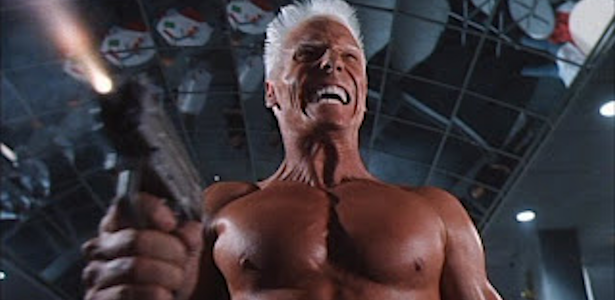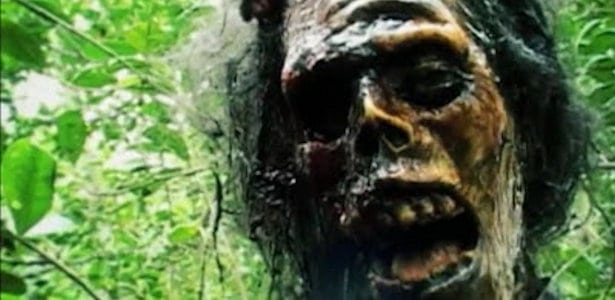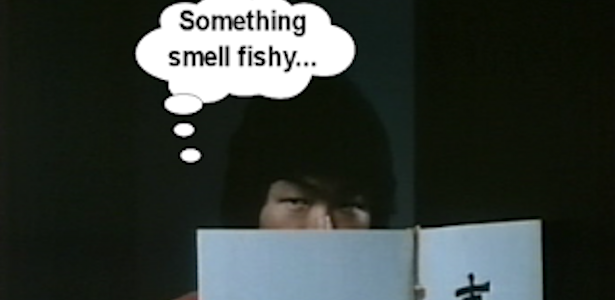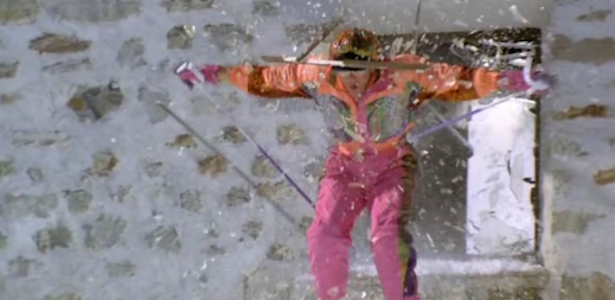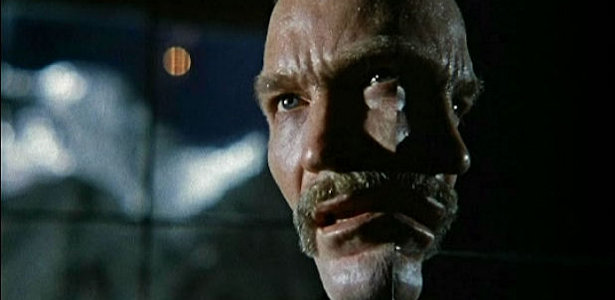Well, here we are a week into our “A Week of Howard Phillips Lovecraft” with no signs of stopping. See, we’re rebels and we refuse to conform to THE MAN’s idea of a week so hopefully you will enjoy the bonus days of more coverage of all things Lovecraftian in cinema. Also, a special thanks to the amazing UNFILMABLE blog for plugging us. Check them for the absolute best news on Lovecraft film projects big and small.
H.P. LOVECRAFT'S THE DUNWICH HORROR (2009) – Hmmm, a modern adaptation of one of Lovecraft’s most well known stories starring Dean Stockwell and Jeffrey Combs? How can you screw this up? Well, leave it to The Asylum alumni (escapee?) Leigh Scott to create a cheap film that not only does disservice to Lovecraft but also genre movies in general. Here we go!
Dr. Henry Armitage (Stockwell), Walter Rice (Griff Furst) and Professor Fay Morgan (Sarah Lieving) are searching for the original copy of the Necronomicon because it has the missing page 751, which outlays the way to open and close portals for the Old Gods. Also looking for this page is Wilbur Whateley (Jeffrey Combs), a ten-year-old boy from a cliché redneck family who has rapidly aged to look forty. Wilbur also has a habit of chloroforming hotties to feed to his twin with tentacles living in the family attic.
This is reminds me of the Corman Poe adaptations. No, not those classic adaptations from the 1960s, but the cheapo Concorde productions from the late 1980s. While it does retain the general plot of Lovecraft's story, nearly everything is left unfulfilled or poorly executed. Director Scott appears to be a Lovecraft fan, yet he contorts the story enough to make it frustrating. For example, Morgan is now made into a woman so we can get the relationship angle with Rice. And the Whateley family is now an inbred redneck family (screeching mom in wig, grandfather in wheelchair) that would give Rob Zombie a boner. Nothing regarding their dabbling in the black arts is referenced.
Of course, poor adaptation can’t be blamed for lame moments like Rice and Morgan visiting a floating fat man with S&M belly dancers in the Louisiana swamps, Necronomicon writer Abdul Alhazred being shown on a cave set measuring 3X3 with the fakest beard EVER or Rice donning a Harry Potter-esque cloak for the final battle. A frustrating translation to the screen is further marred by Scott’s insistence that he has some sense of style. He fills the movie with fade outs for no reason in the middle of scenes, annoying glitches and hyper-edits every ten seconds. If you didn’t know it was intended to look like this, you’d be kicking your TiVo and screaming, “Stop screwing up!”
And then there are the effects. Whooooo boy! The monster is laughable, looking like Martian queen from INVADERS FROM MARS (1953) crossed with Grace Jones (see pics). Even Scott might have sensed how bad this thing looks as he keeps the glimpses brief. The storm effects during the final black magic showdown at the Whateley farm are worthy of the Sci-Fi, er, SyFy Channel, which is where this disaster fittingly debuted last fall. What does it say about your film when you can see better effects work during a Bosley hair restoration ad during a commercial break?
In fact, the only interesting thing about it is that Dean Stockwell also starred as Wilbur in the 1970 adaptation of the story, a fact that Scott fails to exploit. Sadly, the scariest thing in the film is Stockwell's gullet that boasts a huge lump that dangles over his shirt collars. I’m not one to endorse plastic surgery but you might want to get that bad boy checked out. Jeffrey Combs actually gives a decent performance as the man-child, one deserving to be in a better film. Furst and Lieving get a majority of the screen time and they are serviceable. So my own lack of judgment at 2am gets me nothing in return. Shocker. I think the tagline on this release of the film (under the title WITCHES) just about sums it this experience up...
H.P. LOVECRAFT'S THE DUNWICH HORROR (2009) – Hmmm, a modern adaptation of one of Lovecraft’s most well known stories starring Dean Stockwell and Jeffrey Combs? How can you screw this up? Well, leave it to The Asylum alumni (escapee?) Leigh Scott to create a cheap film that not only does disservice to Lovecraft but also genre movies in general. Here we go!
Dr. Henry Armitage (Stockwell), Walter Rice (Griff Furst) and Professor Fay Morgan (Sarah Lieving) are searching for the original copy of the Necronomicon because it has the missing page 751, which outlays the way to open and close portals for the Old Gods. Also looking for this page is Wilbur Whateley (Jeffrey Combs), a ten-year-old boy from a cliché redneck family who has rapidly aged to look forty. Wilbur also has a habit of chloroforming hotties to feed to his twin with tentacles living in the family attic.
This is reminds me of the Corman Poe adaptations. No, not those classic adaptations from the 1960s, but the cheapo Concorde productions from the late 1980s. While it does retain the general plot of Lovecraft's story, nearly everything is left unfulfilled or poorly executed. Director Scott appears to be a Lovecraft fan, yet he contorts the story enough to make it frustrating. For example, Morgan is now made into a woman so we can get the relationship angle with Rice. And the Whateley family is now an inbred redneck family (screeching mom in wig, grandfather in wheelchair) that would give Rob Zombie a boner. Nothing regarding their dabbling in the black arts is referenced.
Of course, poor adaptation can’t be blamed for lame moments like Rice and Morgan visiting a floating fat man with S&M belly dancers in the Louisiana swamps, Necronomicon writer Abdul Alhazred being shown on a cave set measuring 3X3 with the fakest beard EVER or Rice donning a Harry Potter-esque cloak for the final battle. A frustrating translation to the screen is further marred by Scott’s insistence that he has some sense of style. He fills the movie with fade outs for no reason in the middle of scenes, annoying glitches and hyper-edits every ten seconds. If you didn’t know it was intended to look like this, you’d be kicking your TiVo and screaming, “Stop screwing up!”
And then there are the effects. Whooooo boy! The monster is laughable, looking like Martian queen from INVADERS FROM MARS (1953) crossed with Grace Jones (see pics). Even Scott might have sensed how bad this thing looks as he keeps the glimpses brief. The storm effects during the final black magic showdown at the Whateley farm are worthy of the Sci-Fi, er, SyFy Channel, which is where this disaster fittingly debuted last fall. What does it say about your film when you can see better effects work during a Bosley hair restoration ad during a commercial break?
Better special effect? This:
Or this:
In fact, the only interesting thing about it is that Dean Stockwell also starred as Wilbur in the 1970 adaptation of the story, a fact that Scott fails to exploit. Sadly, the scariest thing in the film is Stockwell's gullet that boasts a huge lump that dangles over his shirt collars. I’m not one to endorse plastic surgery but you might want to get that bad boy checked out. Jeffrey Combs actually gives a decent performance as the man-child, one deserving to be in a better film. Furst and Lieving get a majority of the screen time and they are serviceable. So my own lack of judgment at 2am gets me nothing in return. Shocker. I think the tagline on this release of the film (under the title WITCHES) just about sums it this experience up...




